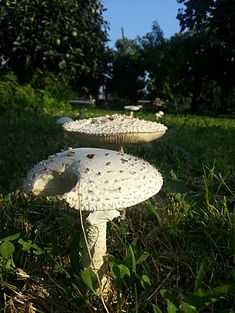Saproamanita
| Saproamanita | |
|---|---|
 |
|
| Saproamanita vittadinii in grass in Italy | |
| Scientific classification | |
| Kingdom: | Fungi |
| Division: | Basidiomycota |
| Class: | Agaricomycetes |
| Order: | Agaricales |
| Family: | Amanitaceae |
| Genus: |
Saproamanita Redhead, Vizzini, Drehmel & Contu (2016) |
| Type species | |
|
Saproamanita vittadinii (Moretti) Redhead, Vizzini, Drehmel & Contu (2016) |
|
| Diversity | |
| c. 23 species | |
| Synonyms | |
|
Lepidella E.-J. Gilbert (1925) |
|
Lepidella E.-J. Gilbert (1925)
Amanita subgen. Lepidella Beauseigneur (1925)
Aspidella E.-J. Gilbert (1940)
Amanita subgen. Aspidella E.-J. Gilbert (1941)
Amanita sect. Lepidella Corner & Bas (1962)
Amanita sect. Aspidella Pomerleau (1966)
Amanita subsect. Vittadinae Bas (1969)
Amanita ser. Vittadinae (Bas) Neville & Poumarat (2004)
The genus Saproamanita contains about 23 species of agarics and is one of four genera in the family Amanitaceae. The others are Amanita (which now includes the synonym Torrendia), Limacella, and Catatrama.Saproamanita are the saprophytic species in the Tribe Amaniteae separately classified from the ectomycorrhizal species in the genus Amanita.
Saproamanita resemble Amanita and have a pileus, free lamellae, a central stipe, and an annulus with scales and rings below the annulus that are the remnants of the universal veil composed largely of cylindrical to slender clavate inflated hyphal cells mostly scattered in the central stipe region rather than the base. The spores are white and amyloid. DNA molecular evidence for the separation of the saprotrophic genus from the sister genus of symbiotic genus Amanita was first detected in a study of mushrooms and their families in 2002 when Saproamanita armillariiformis [under the name Amanita armillariiformis] appeared basal to Amanita. Later studies supported by larger samplings of species and additional gene regions in investigations of the family Amanitaceae expanded the sampling of both groups of species that were all considered to be Amanita species or separated into two genera under the names Aspidella and Amanita. In the most detailed study of decomposition pathway enzymes that supports taxonomic separation, the subgeneric name Amanita subgen. Lepidella was applied to a group of species that did not include the type species of the subgenus. That group is correctly named Amanita subgen. Amanitina.
...
Wikipedia
